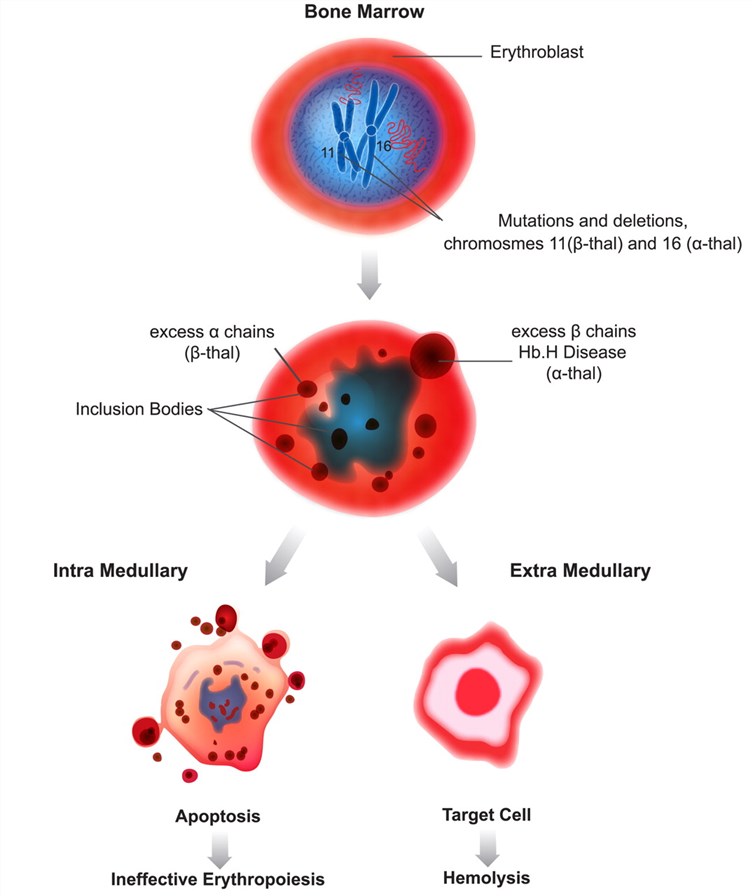Thalassemia
Thalassemia is a group of inherited blood disorders associated with chromosomal abnormalities that affect the formation and function of red blood cells (RBCs), leading to symptoms such as anemia, jaundice, and splenomegaly. Thalassemia is classified into alpha (α) and beta (β) types based on mutations in the α-globin or β-globin genes, encoding hemoglobin subunits, the oxygen-carrying protein in RBCs. Thalassemia exhibits a heterogeneous global distribution, with higher prevalence in the Mediterranean region, Africa, the Middle East, India, and Southeast Asia. Incidence and inheritance patterns depend on the type and number of gene mutations involved.
 Fig.1 Mechanism of IE and hemolysis in thalassemia. (Rachmilewitz EA, 2011)
Fig.1 Mechanism of IE and hemolysis in thalassemia. (Rachmilewitz EA, 2011)
Clinical Manifestations
Symptoms of thalassemia range from asymptomatic to severe anemia, varying based on the disorder's type and severity. Generally, α-thalassemia is milder than β-thalassemia because the deficiency of α-globin can be partially compensated by other globin chains. β-thalassemia is further divided into major (β0) and minor (β+) types, depending on complete or partial absence of β-globin. β-thalassemia major patients typically present severe anemia, growth retardation, facial deformities, skeletal abnormalities, cardiac problems, and other complications in infancy, requiring regular blood transfusions for survival. β-thalassemia minor patients exhibit mild or moderate anemia, jaundice, splenomegaly, and other symptoms in childhood or adulthood, sometimes not necessitating blood transfusions.
Thalassemia, a genetic disorder impacting red blood cells, can lead to anemia and various complications, manifesting as pale or yellow skin, fatigue, weakness, rapid heartbeat, enlarged spleen or liver, bone deformities, delayed growth or puberty, dark urine, iron metabolism issues, and susceptibility to infections. These symptoms affect patients' quality of life and prognosis, necessitating timely diagnosis and treatment.
Clinical Diagnosis and Treatment
Thalassemia diagnosis relies on laboratory tests, including complete blood count, RBC morphology, RBC indices, hemoglobin electrophoresis, iron metabolism markers, DNA analysis, and others. These tests determine thalassemia type and severity, and identify coexisting conditions or complications. Treatment methods include blood transfusion therapy, iron chelation therapy, bone marrow transplantation, and gene therapy. Blood transfusions, the most common treatment, improve anemia and quality of life but may lead to iron overload and transfusion reactions. Iron chelation therapy prevents iron-induced organ damage, requiring long-term specific drug use. Bone marrow transplantation, the sole curative method, involves risks like donor matching difficulties and graft-versus-host disease. Gene therapy, a promising but experimental approach, aims to restore normal RBC function by repairing or replacing damaged genes, currently in clinical trials.
Conclusion
Thalassemia, a prevalent inherited blood disorder with chromosomal abnormalities, causes anemia and complications. Diagnosis and treatment require considering patient genotype, phenotype, age, comorbidities, and other factors for an individualized plan. Prevention involves genetic counseling, prenatal and newborn screening, raising public awareness, and research must explore new diagnostic and treatment methods for enhanced patient outcomes and quality of life.
References
- Angelucci E, et al. Hematopoietic stem cell transplantation in thalassemia major and sickle cell disease: indications and management recommendations from an international expert panel. Haematologica. 2014 May;99(5):811-20.
- Rachmilewitz EA, Giardina PJ. How I treat thalassemia. Blood. 2011 Sep 29;118(13):3479-88.
- Cavazzana M, et al. Gene therapy for β-thalassemia. N Engl J Med. 2018 May 17;378(20):1878-80.
- Choudhry VP, et al. Management of thalassemia: consensus 2016. Indian J Pediatr. 2016 Sep;83(9):1065-76.
- Cui S, et al. Targeted gene addition in human CD34+ hematopoietic cells for correction of X-linked chronic granulomatous disease. Nat Biotechnol. 2016 Apr;34(4):424-9.
- Kwiatkowski JL, et al. Clinical outcomes in patients with hemoglobinopathies given either cord blood or bone marrow transplantation from an HLA-identical sibling. Blood Adv. 2020 Jul 14;4(13):3187-97.
- Li H, et al. CRISPR-Cas9-mediated correction of β-thalassemia mutations at the endogenous HBB locus in human CD34+ hematopoietic stem and progenitor cells. Mol Ther Methods Clin Dev. 2020 Jun 12;17:589-600.
- Musallam KM, et al. Life expectancy and mortality in patients with thalassemia major in the United Kingdom: a hybrid study design using nationwide registry data and a historical cohort study from a single center in London over four decades (1976–2015). Am J Hematol. 2020 Feb;95(2):156-64.
- Piga A, et al. Luspatercept improves hemoglobin levels and blood transfusion requirements in a study of patients with β-thalassemia not eligible for intensive curative therapies (BELIEVE). Blood Adv. 2020 Dec 22;4(24):6118-28.
- Rivella S, et al. Modulation of erythropoiesis by the molecular regulation of hepcidin expression and activity: implications for the treatment of anemias associated with iron overload and iron deficiency states such as β-thalassemia and hereditary hemochromatosis. Hematol Oncol Clin North Am. 2018 Jun;32(3):397-413.
- Sadelain M, et al. Therapeutic gene editing: delivery and regulatory perspectives. Nat Med. 2020 Jun;26(6):858-66.
- Taher AT, et al. New film-coated tablet formulation of deferasirox is well tolerated in patients with thalassemia or lower-risk MDS: results of the randomized, phase II ECLIPSE study. Am J Hematol. 2017 Mar;92(3):420-8.
- Thompson AA, et al. Gene therapy in patients with transfusion-dependent β-thalassemia. N Engl J Med. 2018 Apr 19;378(16):1479-93.
